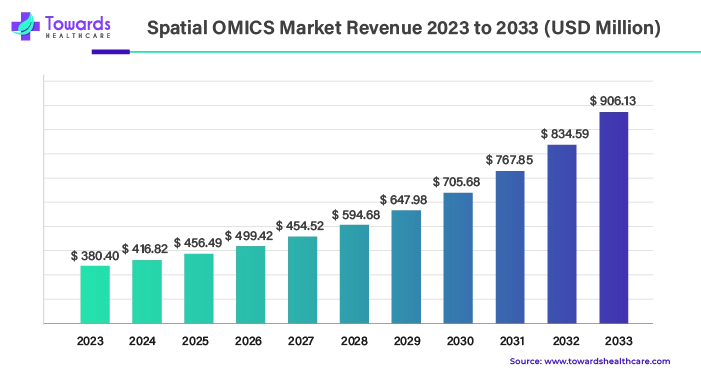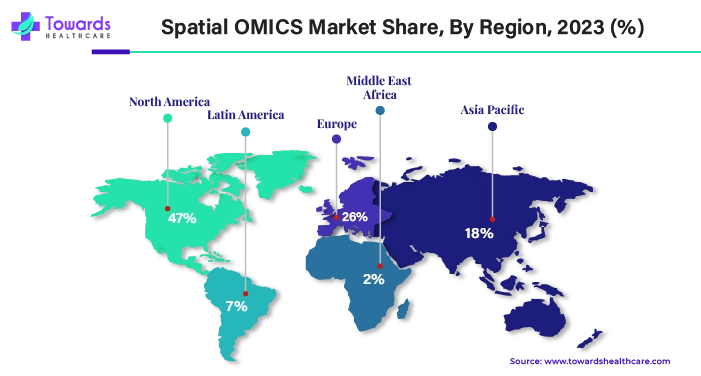April 2025


Principal Consultant

Reviewed By
The global spatial OMICS market size was estimated at USD 380.4 million in 2023 and is projected to grow to USD 906.13 million by 2033, rising at a compound annual growth rate (CAGR) of 9.50% from 2024 to 2033. Global advancements in sequencing technology, the growing incidence of genetic disorders, and increased funding for OMICS research are some of the reasons propelling the market.

The spatial OMICS market provides high-throughput methods for evaluating the spatial organization, cell kinds, and intercellular communication inside niches. The application of spatial omics, which integrates next-generation seq/high-level multiplexing with imaging modalities, deepens and clarifies our understanding of the spatial distribution of gene expression, cell-state transitions and cell-cell interactions. Many have hailed spatial OMICS as the next big thing in the biological sciences. This concept refers to a broad spectrum of methods that hold the potential to revolutionize pathology and many other areas of biology.
From 2025 to 2030, the spatial OMICS market is set to experience impressive growth. The market, valued at around USD 456.49 million in 2025, is expected to reach approximately USD 705.68 million by 2030, with a robust compound annual growth rate (CAGR) of 9.50%. This growth will be fueled by ongoing advancements in sequencing technology, a rising number of genetic disorders, and increased funding for OMICS research, which together will drive broader adoption and innovation in the field.
Artificial intelligence (AI) is a potent tool for resolving challenging issues when it comes to processing, analyzing, and interpreting omics data and integrating multi-omics and clinical data. In recent years, AI has made significant strides possible in a variety of biomedical domains. Spatial transcriptome analysis using artificial intelligence provides new insights into complex tissues like tumor microenvironments and improves our understanding of biological interactions at the cellular level.
For instance,
| Company Name | Firalis Molecular Precision |
| Headquarters | Huningue, France, Europe |
| Recent Development | In March 2024, introducing a Grant Program open to researchers in Europe, Firalis Molecular Precision (FMP), a rapidly expanding Contract Research Organization (CRO) and Contract Development and Manufacturing Organization (CDMO) accredited by CAP, is excited to announce a partnership with Vizgen, a leader in the field of spatial omics technology. |
| Company Name | 10X Genomics Inc. |
| Headquarters | California, U.S., North America |
| Recent Development | In March 2024, 10x Genomics, Inc., a leading company in single-cell and spatial biology, announced today that its Visium HD Spatial Gene Expression tool is now available for purchase. With this assay, scientists can measure the entire transcriptome from FFPE tissue slices with a resolution of just one cell. |
Spatial omics facilitate the growing emphasis on personalized and precision medicine, which modifies treatment plans based on unique patient traits. The increasing medical acceptance of spatial omics is attributed to technological developments that have made it more accessible and useful in clinical settings. These advancements are typified by high-resolution imaging and multiplexed analysis platforms. Spatial omics' growing therapeutic importance in a variety of medical domains is mostly due to its developing applicability in neurology, infectious diseases, and genetic disorders. The global spatial OMICS market is anticipated to grow over the projected period as new applications of the technology are found and its usage increases.
Raising the repeatability and fidelity of the results is a major practical problem in the quickly expanding field of spatial omics, where many technologies are still in the early stages of development. Unwanted changes in the results can be introduced by small variances in sample handling, probe preparations, staining techniques, and instruments, especially when it comes to coverage, background, and sensitivity.
A promising method for thoroughly analyzing cells in tissues is spatial multi-omic investigations, which allow for the joint study of several data modalities such as transcriptome, epigenome, proteome, and metabolome in concurrently or even inside the same tissue segment. The use of spatial multi-omics has the potential to significantly advance our knowledge of human disease processes and the discovery of new biomarkers and treatment targets. The topic of spatial multi-omics is poised for exciting prospects and is expected to play a role in advancing tailored treatment for cardiovascular disorders.
The spatial transcriptomics segment held the largest share of the spatial OMICS market in 2023. The rapidly developing area of spatial transcriptomics holds the potential to provide a thorough characterization of tissue architecture and organization at the single-cell or subcellular level. Such data, which is not possible to gather with conventional technologies, offers a strong foundation for the mechanistic understanding of numerous biological processes in both health and illness.
For instance,
The spatial genomics segment is expected to register the fastest CAGR in the spatial OMICS market during 2024-2033. Innovative research in spatial genomics uses a combination of genomics and spatial analysis to examine the impact of genomic characteristics in disease at the single-cell level. Spatial genomics is an extremely promising area. Future developments could focus on improving Multi-Omics integration, improving spatial resolution, and characterizing single cells and their clinical uses.
For instance,
The consumables segment dominated the spatial OMICS market in 2023. Reagents, probes, and assay kits are examples of consumables that are necessary for spatial OMICS techniques, which allow researchers to precisely investigate the spatial distribution of biomolecules inside tissues or cells. They are essential to the processing and analysis of samples.
The software segment is anticipated to grow at a significant rate in the spatial OMICS market during the forecast period. Software and data solutions firms are a growing segment of this market. Applications for image analysis such as quantification, segmentation, regression model development, measurement of spatial and morphological metrics, analysis of serial sample sections, and much more can be automated, standardized, and expedited.
For instance,
The instrumental analysis segment dominated the spatial OMICS market in 2023. The application of cutting-edge technologies to map the spatial distribution of biomolecules within biological tissues is known as instrumental analysis in spatial omics. It has uses in neurology, personalized medicine, cancer research, medication development, and diagnostics.
The data analysis segment is estimated to grow at a lucrative rate in the spatial OMICS market during the predicted period. New tools for organizing, loading, and visualizing spatial omics data have been developed as a result of advances in spatial omics technology, which have increased the understanding of cellular organization in tissues. These technological advancements have also generated complicated and heterogeneous data.
The FFPE segment held the largest share of the spatial OMICS market in 2023. For long-term tissue preservation, formalin-fixed paraffin embedding (FFPE) is the most commonly used method. FFPE gives a high degree of morphological detail preservation and is less costly and simpler to utilize. Because of this, biobanks have enormous amounts of FFPE specimens that are easily accessible for genomics research. These specimens could be used for lengthy longitudinal investigations involving sizable patient cohorts.
For instance,
The fresh frozen segment is expected to grow at the fastest CAGR in the spatial OMICS market during the forecast period. Because fresh frozen sample type may keep both spatial information and biomolecule integrity, its use in the spatial omics market is increasing. Researchers can do more precise spatial analysis with fresh frozen samples because they give them a snapshot of the tissue's molecular composition at the time of collection. Furthermore, the increasing efficiency of dealing with fresh frozen samples due to innovations in sample preparation techniques has led to an increased use of these samples in spatial omics research.
The academic & translational research institute segment held the largest share of the spatial OMICS market in 2023. Academic research aims to increase knowledge and is relevant when it solves issues that benefit society as a whole. The goal of translational research is to translate scientific advances into improved health. This enhanced approach guarantees that teams share expertise, which grows with each partnership, and that patients' needs come first. In addition, these groups produce a feedback loop that is critical to the translational route.
The pharmaceutical & biotechnology companies segment is anticipated to show significant growth in the spatial OMICS market during the predicted period. Pharma and biotech R&D will soon be dependent on spatial omics datasets from patient biopsies. By applying AI techniques, these datasets will be used to guide the development of novel, more effective medications and expedite and improve the design of clinical trials that will eventually be conducted to deliver those medications to patients.

North America dominated the spatial OMICS market by 47% in 2023. Due in large part to substantial investment made in research and development in countries like the U.S. and Canada, as well as the presence of biotechnology and research companies as well as academic institutions, the global spatial OMICS market is expanding significantly throughout the Americas.
The U.S. holds the largest share of the spatial OMICS market in the North American region due to the presence of a strong biotechnology industry.
In order to increase biomanufacturing's capacity to create antibiotics, active pharmaceutical ingredients (APIs), and critical starting materials for the production of life-saving drugs and pandemic response, the Department of Health and Human Services committed $40 million. USDA announced in March 2022 that it will be investing $68 million to train the next generation of researchers through the Agriculture and Food Research Initiative. To develop measuring methods, standards, and data for the U.S. bioeconomy, DOC contributed an additional $14 million in biotechnology research initiatives at the National Institute of Standards and Technology. Recently, the NSF announced a competition to build a $20 million biosciences data center. The goal of this facility is to improve our understanding of living systems at tiny scales and develop novel biotechnology designs that would enable the production of various products.
Asia Pacific is expected to grow at the fastest rate during the forecast period. Considering the expanding biotechnology industries and rising government support for scientific research in large nations like China and India, the Asia Pacific area has significant growth potential for spatial OMICS. Due to significant expenditures made by its Department of Biotechnology (DBT), India is increasingly implementing spatial OMIC technology. This could open up opportunities for collaborations between researchers and industry participants who are interested in these cutting-edge applications.
China holds a substantial share of the spatial OMICS market in the Asia Pacific region.
The government's main strategy document, Made in China 2025, lays out the country's goal of becoming a global leader in high-tech and high-value industries, including biopharmaceuticals and other medical technology, robots, advanced IT, aviation, and new energy vehicles. The roadmap, which focuses on biotechnology, outlines specific objectives for licensing three to five new biotech drugs and the diagnostic reagents that go along with them in advanced economies by 2020. It also outlines the commercialization of thirty to thirty-five innovative drugs (of all kinds) by 2025, in addition to the more general objective of attaining world-class innovation capacity, production volume, and international competitiveness in pharmaceuticals by the same year.
India is the third-largest biotechnology destination in the Asia Pacific and is ranked in the Top 12 worldwide.
In the last eleven years, the worth of India's BioEconomy has increased significantly, with an expected $130 billion in revenue in 2024. The Department of Biotechnology (DBT) received $ 271 million (about Rs. 2,251.52 crore) in the Interim Budget 2024–25. The 101 projects that the National Biopharma Mission is funding include 30 MSMEs and over 150 nonprofits. The government has a platform to enhance creativity, resourcefulness, and skill development, all of which come together to establish a robust ecosystem for information exchange, thanks to the National Biotechnology Development Strategy 2020–25.
By Technology
By Product
By Workflow
By Sample Type
By End-use
By Region
Microfluidics is a field that involves manipulating a limited number of fluids through channels measuring from ten to several hundred micrometers. This technology integrates the study of fluid behavior within microchannels with the creation of miniaturized devices featuring chambers and pathways for fluid movement or containment. It encompasses various interdisciplinary fields, including molecular biology, microelectronics, and analytical science.
Microfluidics is increasingly incorporated into the design of low-volume fluid processing systems to achieve high-throughput screening, multiplexing, and automation. The growing adoption of microfluidics in point-of-care diagnostics, advancements in diagnostic devices, and the rising global prevalence of chronic diseases are key drivers of market growth.
April 2025
April 2025
April 2025
April 2025